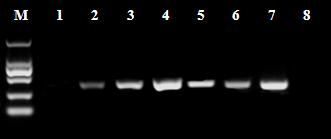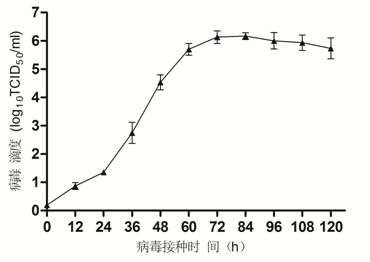Cell culture method for duck flavivirus
A technology of cell culture and duck yellow virus, applied in the direction of virus/bacteriophage, biochemical equipment and methods, microorganisms, etc., can solve the problems that cannot meet the needs of virus molecular biology research, fail to find cell culture methods, limit molecular pathogenic mechanisms and Genetic engineering vaccine research and other issues, to achieve the effect of an intuitive virus operation platform
- Summary
- Abstract
- Description
- Claims
- Application Information
AI Technical Summary
Problems solved by technology
Method used
Image
Examples
Embodiment 1
[0025] Embodiment 1, the adaptive passage of virus
[0026] 1. Cultivate BHK21 cells in a plastic culture dish with a diameter of 6 cm to form a monolayer.
[0027] 2. Inoculate the seed virus on BHK21 cells (ATCC Number: CCL-10), and place in 5% CO at 37°C 2 Incubate in the incubator for 45-60 minutes, and shake well every 10 minutes during this period.
[0028] 3. Wash the unadsorbed virus with sterile PBS buffer, discard the washing solution, and repeat 1-2 times.
[0029] 4. Add 12-15mL cell maintenance solution (DMEM (Gibco) containing 2-3% fetal bovine serum (Gibco) and 1% double antibody (Fermentas)) and place at 37°C, 5% CO 2 to cultivate.
[0030] 5. Observe twice a day, record the cell state and pathological changes, and observe continuously for 5 days.
[0031] 6. Freeze and thaw the cell culture 3 times on the 5th day or after serious cell lesions appear, take an appropriate amount of culture as seed poison for the next round of subculture, and repeat steps 1-6...
Embodiment 2
[0033] The RT-PCR identification of embodiment 2 virus
[0034] During the passaging process, the cell cultures of the 1st, 3rd, 5th, 7th, 9th, 11th, and 13th passages were selected, and duck flavivirus-specific detection primers (P1: 5'-ctt gca aaa cgt ggt aaa tat ggc-3 ';P2: 5'-tgt acc aaa tag ctc tac ta-3') was identified by RT-PCR. This primer can specifically amplify some gene fragments of duck yellow virus. The fragment size is 400bp. The operation steps refer to the literature (2) method.
[0035] 1. Extraction of viral RNA
[0036] Extraction of total RNA from cell culture was carried out according to the instructions of Trizol LS Reagent (Invtrogen). Specifically: Take 0.25ml of culture supernatant, add 0.75ml TRIZOL, mix well, place at 15-30°C for 5min, add 0.2ml of chloroform, shake the centrifuge tube for 15sec, place at room temperature for 2-5min, centrifuge at 2-8°C at no more than 12000g for 15min , transfer the upper liquid phase to another tube (don't suck...
Embodiment 3
[0051] Example 3 Growth Characteristics of Cell Adaptation Toxins
[0052] In order to understand the growth characteristics of the cell-adapted virus on BHK21 cells, the 8th generation cell culture was frozen and thawed three times and then used as seed virus to inoculate BHK21 cells, and the virus titers at different time points were measured (the results were expressed as TCID 50 Indicated), the determination method refers to literature (3), specifically:
[0053] After virus seeds were inoculated into BHK21 cells, 100ul of cell supernatants were taken at 0, 12, 24, 36, 48, 60, 72, 84, 96, 108 and 120 hours after inoculation respectively, and the virus content in cell supernatants at different time points was measured (with TCID 50 express).
PUM
 Login to View More
Login to View More Abstract
Description
Claims
Application Information
 Login to View More
Login to View More - R&D
- Intellectual Property
- Life Sciences
- Materials
- Tech Scout
- Unparalleled Data Quality
- Higher Quality Content
- 60% Fewer Hallucinations
Browse by: Latest US Patents, China's latest patents, Technical Efficacy Thesaurus, Application Domain, Technology Topic, Popular Technical Reports.
© 2025 PatSnap. All rights reserved.Legal|Privacy policy|Modern Slavery Act Transparency Statement|Sitemap|About US| Contact US: help@patsnap.com



